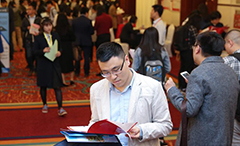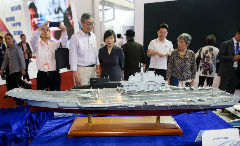Further reform, opening-up to better serve global growth
2018-05-14
China Daily
Four decades after its reform and opening-up, China retains its allure as a vast, growing market and an investment destination while becoming a big source of investment.
This is expected to enable the world’s second-largest economy to remain an engine of global growth as well as contribute more to globalization and free trade by creating new growth points and business opportunities.
Such an outlook has found support in China’s first-quarter economic and trade data on top of steps taken this year to broaden market access as a way to further open up in a shift toward a high-quality growth.
Increased investor confidence can be seen as an indicator of how China’s further reform and opening-up has affected the economy.
The investor confidence in China’s economic performance was recently showcased by the JP Morgan Chase’s Global China Summit held in Beijing on May 8 and 9 and attended by 2,200 investors and corporate executives from 50 countries and regions.
“Investors from around the world are moving to add investment here in preparation for opportunities to emerge in the future,” said Jing Ulrich, managing director and vice-chair of the New York-based bank’s Asia Pacific region.
For example, an investment facilitation policy adopted in late April in China’s financial sector, which licenses foreign investors to set up securities trading firms with holding status, has triggered swift market reactions.
JP Morgan Broking (Hong Kong) Ltd has made such an application, planning to hold 51 percent of the stakes. Japan’s largest securities trader Nomura has released a plan to set up a holding firm in China.
Considered a milestone in the internationalization of China’s capital market, global index provider MSCI will list a number of China A-shares in its market indexes beginning June.
The measures provide new channels for global investors to share in the big cake of China’s strong growth.
Steps to open up further
Manufacturing is another key sector to reduce restrictions on foreign investment. Regarding trade, China called off import tariffs on anticancer drugs beginning this month and will significantly lower tariffs on vehicles and other goods.
They are among the concrete measures outlined by President Xi Jinping at the annual conference of the Boao Forum for Asia in April in Hainan province.
“We have a genuine desire to increase imports and achieve greater balance of international payments under the current account,” Xi said in the keynote speech. The first China International Import Expo scheduled for November in Shanghai is expected to help increase imports.
In addition, Hainan island will become a pilot free-trade zone and, eventually, a free-trade port, Xi said during an inspection tour there after attending Boao gathering.
The moves reaffirmed a strong political will and a road map to deepen China’s reform and opening-up that began at the 19th National Congress of the Communist Party of China in October.
Support from data
China reported year-on-year GDP growth of 6.8 percent in the first quarter, the 11th quarter in a row with a growth rate between 6.7 percent and 6.9 percent.
Consumption contributed 77.8 percent, more than last year’s average of 58.8 percent, continuing an uptrend that began five years ago.
In 2018, China’s total retail sales of consumer goods are estimated to reach 40.5 trillion yuan ($6.4 trillion), replacing the United States as the world’s largest retail market, said Wang Changlin, an economic expert with the State Development and Reform Commission.
Services accounted for 61.6 percent of the first-quarter growth, consolidating a leading role that marks an economic structural transformation, the National Bureau of Statistics said, attributing this partly to changes in China’s consumption structure.
“Rapidly growing per capita disposable income and a high employment rate will sustain robust consumption,” JP Morgan Chase’s Ulrich said.
Today, China is the major trading partner of over 120 countries and regions. In the first quarter, customs data recorded a 21.8 percent drop in China’s trade surplus, with imports rising 11.7 percent and exports 7.4 percent.
A country of net capital outflows since 2015, China in the first quarter has maintained for five months an increase in its outward foreign direct investment, reaching a total volume of $25.5 billion in 140 countries and regions.
Engine for global growth
According to the World Bank, China has maintained an annual growth rate of 7.1 percent during the past five years, contributing over 30 percent of global economic growth, more than the contribution made by the US, the Eurozone countries and Japan combined.
Xi voiced China’s staunch support for free and inclusive trade at the Boao conference, saying globalization is in line with the common interests of all countries.
“We will continue to safeguard international order and rules and support free trade and the liberalization and facilitation of trade and investment,” Xi said at the four-day meeting.
“The international community should abandon the Cold War mentality and advocate working together to build a community with a shared future for mankind,” he said.
To make globalization more inclusive so that its benefits can be shared more extensively, Beijing has launched the Belt and Road Initiative and is asking others to join it.
Proposed by Xi in 2013, the initiative aims to achieve policy, infrastructure, trade, financial and people-to-people connectivity along and beyond the ancient Silk Road trade routes, building a platform for international cooperation to create new growth drivers.
“China’s pledge to continue to deepen reform and opening-up by liberalizing market access and reducing trade barriers sends a clear signal that it wishes to not only improve itself, but to inclusively share the benefits derived from China’s development model,” Jon R. Taylor, a US political science professor at University of St. Thomas in Houston, told Xinhua in April.


